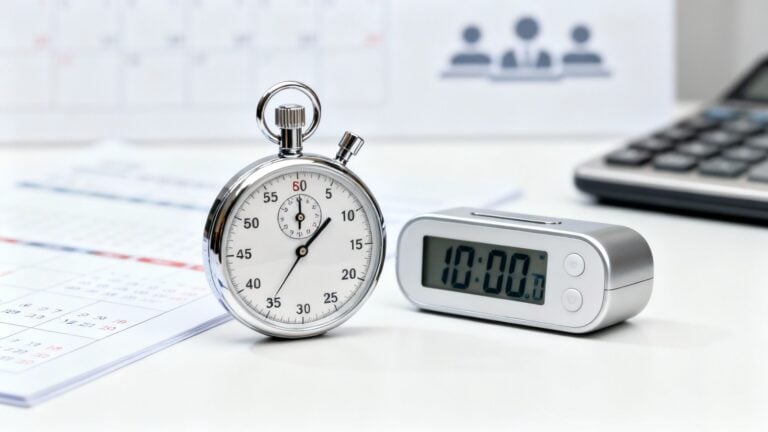Your client wants to know how you calculated their bill. You pull up the report from your time-tracking software, and it clearly outlines all the billable hours, neatly organized by task. This is just one of the key benefits of accurately tracking billable hours. With the right software, you can keep clients happy and your projects profitable. In this article, we’ll compare Hubstaff vs Timedoctor to help you choose the best time tracking tool for your business.
Tackle’s automatic time tracking software can ease the transition to tracking billable hours, making the process more accurate and less stressful.
Hubstaff vs Time Doctor at a Glance

Hubstaff and Time Doctor are both widely used time-tracking and employee-monitoring tools that cater to remote, hybrid, and in-office teams. While they share core functionalities such as time tracking, productivity monitoring, and integration with other business tools, they differ in terms of focus and user experience.
Time Doctor
Time Doctor offers manual, automatic, and silent tracking options, as well as website and app monitoring, and detects idle time. It provides in-depth analytics that highlight how time is spent, uncover inefficiencies, and support productivity assessments. This makes Time Doctor a good choice for teams that need detailed insights into employee work habits and performance.
Hubstaff
Hubstaff focuses more on automated tracking, including features such as activity monitoring and GPS tracking, which are especially useful for teams working in the field. While Hubstaff does offer productivity reporting, its reports primarily focus on activity levels and usage data related to specific apps, websites, and projects.
In terms of ease of use, both platforms are relatively user-friendly. Time Doctor’s desktop interface is intuitive, although its mobile app does lack some advanced functionality. Hubstaff also offers a straightforward onboarding experience, though users often note that the mobile app could benefit from improvements in design and usability.
Related Reading
- What Are Billable Hours
- Invoice for Hours Worked
- Billable Hours vs Actual Hours
- How to Bill a Client
- Bill Rate vs Pay Rate
What is Hubstaff?

Hubstaff is a straightforward time-tracking and productivity-monitoring tool designed for deskless, office-based, and hybrid teams. Hubstaff suits office-based teams better than field and mobile teams, thanks to its powerful desktop-only tools.
For example, the activity-monitoring tool, one of Hubstaff’s essential features, works on Windows, Mac, and Linux devices only. This makes it ideal for businesses that want to track desktop activity and monitor employee productivity. The feature doesn’t engage in intrusive tracking as it captures screenshots, URLs, apps, and keystrokes when the employee is clocked in.
Limitations of Hubstaff’s Mobile App for Field Employees
Hubstaff’s mobile app, an essential tool for field employees, is bare-bones. Noticed the app tracks the time and location of field employees, but some of its features are half-baked. For example, geofencing doesn’t prevent employees from clocking in outside their work sites.
The break tracker doesn’t stop employees from ending breaks early, and the overtime policy doesn’t support daily overtime and double-time tracking. The scheduling module doesn’t let managers add project and location details to employee shifts. The gaps in Hubstaff’s system are deal-breakers for businesses with a mobile workforce.
Hubstaff Features: What Can It Do?
- Time tracking: Hubstaff tracks regular hours, overtime, and work breaks on a smartphone, desktop, web app, and Chrome extension.
- Activity monitoring: Hubstaff records keystrokes, captures screenshots, and monitors the applications and URLs an employee visits during work hours.
- Scheduling: Hubstaff doesn’t support drag-and-drop scheduling, but creating and assigning shifts is a breeze.
- Project management: Hubstaff offers an agile, visual project management module with list, Kanban, and timeline views.
- Time-off management: Hubstaff enables employees to request time off and track their time-off balances on desktop devices. Managers can quickly approve requests only on their desktop devices.
- Insights: Aggregates activity monitoring data and presents it in a visually appealing manner to help managers see team performance at a glance.
What are the Pros of Hubstaff?
- Easy-to-use mobile, desktop and web apps
- Robust time tracker with overtime and break tracking
- Geofenced time-tracking
- Affordable pricing on the annual billing.
What are the Cons of Hubstaff?
- Geofence doesn’t stop employees from clocking in outside job sites
- Doesn’t let you create shifts with projects and location data
- Doesn’t support facial recognition or biometric verification
What is Time Doctor?

Time Doctor is a time-tracking and productivity-monitoring software designed for remote teams, freelancers, and companies with remote or hybrid work setups. It accurately tracks time spent on tasks, projects, and clients, making it ideal for businesses that bill by the hour or need to optimize productivity.
The software’s detailed insights into work patterns, distraction alerts, and project management features help you keep your teams focused and accountable. Its strict monitoring aspects, such as screenshots and activity tracking, may be perceived as invasive by some employees, potentially impacting their morale. While Time Doctor excels in productivity optimization and accurate billing, it lacks GPS tracking and advanced scheduling and communication tools, which are essential for some businesses.
Key Features
- Time tracking: Accurately logs time spent on tasks, projects, and clients with a single click.
- Screenshot capture: Periodically captures screenshots of employees’ screens to verify work being done.
- Activity levels: Monitors keyboard and mouse activity to measure productivity levels.
- Web & app usage tracking: Tracks time spent on various websites and applications to identify potential distractions.
- Distraction alerts: Notifies users when they visit non-work-related sites, encouraging self-discipline.
- Idle alerts: Alerts managers of extended idle time or unusual activity patterns.
- Project management: Lets you assign tasks to team members and track progress within the software.
- Payroll and invoicing: Automates payroll based on tracked hours and generates accurate client invoices.
- Offline time tracking: Records time even without an internet connection, syncing when back online.
- Scheduling: Offers basic scheduling with start and end times for shifts and leave.
- Integrations: Works with popular tools like Asana, Trello, Slack, and more.
Pros
- Enhances accountability and reduces time-wasting.
- Offers detailed reports for better project management.
- Turns logged time into automated timesheets.
Cons
- Monitoring features may be perceived as invasive by some employees.
- The user interface could be more intuitive compared to some competitors.
- The syncing between the PC and mobile apps can be inaccurate.
Tackle: Automated Time Tracking and Insights
Tackle revolutionizes time tracking through seamless calendar integration, eliminating the need for manual logging. Our platform automatically captures and categorizes your time, providing actionable insights through intuitive dashboards and reports.
We’ve built everything you need into one seamless package:
- An intelligent tagging system that works its way
- AI-powered automation to handle the tedious stuff
- Flexible reporting tools to track what matters
- Intelligent time capture right in your browser
Trusted by teams at Roblox, Deel, and Lightspeed Ventures, Tackle helps executives, team leaders, and customer-facing professionals understand and optimize their time allocation.
Simply connect your Google or Outlook calendar, set up custom tags and automations, and gain valuable insights into how your team spends their time. Whether you’re tracking strategic initiatives, measuring team efficiency, or ensuring resource optimization, Tackle transforms time monitoring from a chore into a powerful decision-making tool.
Start using our automatic time tracking software for free with one click today!
Related Reading
- How to Track Virtual Assistant Hours
- Attorney Time Tracking Software
- Time Tracking and Invoicing for Freelancers
- Toggl vs Timely
- Clockify vs Harvest
- Project Management and Billing Software
Hubstaff vs Time Doctor: Key Feature Comparison

Time Doctor gives businesses a high degree of control over how time is tracked. It supports both manual and automatic time tracking, and there’s also an option for silent tracking that runs in the background. This flexibility enables employees to manage their time effectively across various tasks. Its interface includes real-time dashboards that help managers spot inefficiencies and understand how work time is distributed.
What sets Time Doctor apart is its detailed session analytics, website and app monitoring, and accurate detection of idle time. These features make it easier to identify distractions and optimise employee workflows.
Hubstaff: Automation and GPS Tracking for Diverse Teams
Hubstaff, in contrast, is geared more towards automation. It automatically records hours, monitors user activity, and can capture screenshots. It also includes app and URL tracking. Where it stands out is in GPS tracking, which is particularly useful for field teams. This ensures that location-based work is recorded accurately.
Hubstaff’s apps work across mobile, desktop, and web platforms, making it easy for employees to log hours regardless of where they are. The platform also enables teams to track paid time off, holidays, and breaks, facilitating accurate payroll management. While Hubstaff is better suited for teams on the move thanks to its GPS features, Time Doctor offers a more flexible and comprehensive set of tracking tools that provide deeper insight into employee work patterns.
The Productivity Report: Doctor vs Hubstaff
Time Doctor places a strong emphasis on productivity management. It provides detailed analytics around time use, task performance, and work habits.
Managers can observe how employees allocate their time and identify areas where improvements are needed. These insights support proactive decision-making and help businesses tackle time-wasting behaviour before it becomes a problem.
Hubstaff
Hubstaff also provides valuable productivity data, including activity levels, time allocation across tasks, and insights into how employees interact with apps and websites. Hubstaff provides project-level analytics, enabling managers to track progress and allocate resources more effectively. Both platforms deliver robust productivity tools.
Time Doctor
Time Doctor is better for performance analysis at the individual level, while Hubstaff may be more practical for businesses focused on team productivity and project timelines.
Onboarding Ease: Getting Started with Time Doctor and Hubstaff
Time Doctor is generally easy to use, particularly on a desktop. The dashboard is clear and makes essential tools, such as time tracking and productivity reporting, readily accessible. However, its mobile app is seen as less intuitive and lacks some of the features available on the desktop.
Hubstaff also excels in this area, with many users praising its clean interface and intuitive navigation. The onboarding experience is smooth, making it easier for new team members to adopt the system. Like Time Doctor, Hubstaff’s mobile app has room for improvement in terms of user experience. Given that both platforms are similarly rated for ease of use but have minor drawbacks on mobile, neither takes a clear lead here.
Integrations: The Time Doctor vs Hubstaff Showdown
Time Doctor leads the way when it comes to integrations. It connects with over 60 widely used tools, including software for project management, CRM, communication, invoicing, and HR. This means companies can integrate Time Doctor with their existing tech stack without significant disruption. Tools like:
- Asana
- Monday.com
- HubSpot
- Google Workspace
- Freshdesk
It is all supported, making it a strong option for teams with varied workflows. Hubstaff offers a more modest set of integrations, just over 3,0, but still covers essential business tools. It connects with platforms like:
- ClickUp
- Jira
- Salesforce
- Paypal
Which should suit many businesses. However, it falls short of the extensive integration range that Time Doctor provides. For companies that rely on multiple tools and want their time tracking software to integrate seamlessly, Time Doctor offers more flexibility.
Pricing: Hubstaff vs Time Doctor
Time Doctor’s pricing starts at $6.70 per user per month for the Basic plan, increasing to $16.70 per user per month for the Premium version. An Enterprise plan is also available with custom pricing. Users can try any plan for free with a 14-day trial, and a selection of add-ons is available for additional monthly fees. Hubstaff’s plans are more budget-friendly.
The entry-level Starter plan costs $4 per seat per month, while the most feature-rich plan, Enterprise, is priced at $25 per seat per month. Hubstaff also offers a 14-day free trial and backs its plans with a 30-day money-back guarantee. For businesses that require cost-effective time tracking with robust functionality, Hubstaff provides a more affordable option. Its flexible pricing and refund policy make it well-suited to teams watching their budget.
Choosing the Best Software for Time Tracking

Finding the right time tracking software is about more than just recording hours. It’s a decision that should reflect how your team works, what insights you need, and how the software fits into your broader operations. Whether you’re managing a small in-office team, a remote workforce, or a mix of both, there are several important factors to consider when evaluating your options.
1. Time Tracking Modes
Good software should offer flexible tracking methods, including manual start/stop timers, automatic tracking, or background (silent) tracking. This enables businesses to select a method that aligns with their workflows without compromising productivity.
Teams with client-facing roles might prefer manual tracking for task-specific logs, while companies managing hourly or shift-based staff may benefit more from automated or silent monitoring.
2. Reporting and Insights
Detailed reports are essential for understanding how time is spent across tasks, projects, and teams. Look for software that provides breakdowns by employee, project, and time period. Features such as idle time detection, activity level monitoring, and application or website usage reports can help identify inefficiencies and highlight areas for improvement.
3. Integrations with Other Tools
The best time tracking software doesn’t operate in isolation. It should integrate with your project management systems, payroll tools, communication platforms, and HR software. This ensures a seamless flow of data across your organisation, reducing manual entry and improving accuracy in reporting and billing.
4. Ease of Use
Software should be easy to set up and intuitive to navigate. A steep learning curve or clunky interface can reduce team adoption and create unnecessary friction. Ensure it works smoothly across desktop and mobile devices, especially if your team is frequently on the go.
5. Pricing and Scalability
Cost is always a factor. While some platforms offer lower entry-level pricing, they may limit functionality. Others may offer more comprehensive features but at a higher monthly rate. Consider whether the software will scale with your business and what additional features you may need as your business grows.
6. Support and Customer Service
Reliable support can make a significant difference, especially during setup or if issues arise. Look for providers that offer responsive customer service, clear documentation, and helpful onboarding resources.
Related Reading
- Timecamp vs Clockify
- Quickbooks Alternatives
- Freshbooks Alternatives
- Accelo Alternatives
- Freshbooks vs Quickbooks
Start Using Our Automatic Time Tracking Software for Free with One Click Today
Tracking time isn’t just for freelancers anymore. Businesses of all sizes are placing a greater emphasis on time tracking to enhance productivity and profitability.
For teams, tracking time can reveal insights into how work is done, uncovering opportunities for optimization and increased efficiency. Automatic time tracking software, in particular, can make the transition to tracking time less painful for teams.
Introduction to Automatic Time Tracking Tools
By automatically recording the time spent on different tasks and projects, it eliminates the need for manual time tracking and reduces disruptions to workflows. Yet not all time tracking tools are the same. Some have features and functionalities that cater to specific industries or use cases.
Others focus on helping teams, while some are better suited for individual contractors. In this article, we compare two of the most popular automatic time tracking tools on the market, Hubstaff and Time Doctor, to help you decide which one is right for you.



